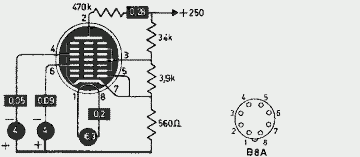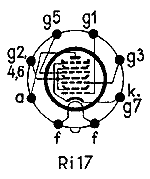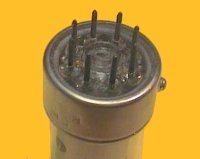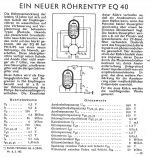
EQ40
|
|
|||||||||||||||||||||||||||||||||||||||||
|
Hits: 5501 Replies: 0
History of the EQ40/EQ80 enneode Frequency Detector - pt2
|
|
|
Pieter Hooijmans
01.Sep.17 |
1
IntroductionIn part 1 I have presented the EQ40/EQ80 enneode valve development and its basic characteristics. In this part I will present the applications of the EQ80 as FM and coincidence detector. The EQ40 and EQ80 used in Television receiversAt this stage, it is interesting to explore how the EQ80 FM detector application circuit developed over time. The first topology is the one used in the home-built TV receiver of my father, based on the latest reference design as used inside the Eindhoven Philips Radiobuizen Lab I (the Radio Valve Laboratory, RBL) mid-1948. The circuit diagram of the sound bar is shown below.
[ FM audio channel of the 1948 Home Built Television Receiver of Piet Hooijmans.] Interestingly (or maybe not) the circuit used in the August 1948 home built TV, in line with the latest reference design, is almost identical to the circuit concept of Fig10. Specifically, R1-R4 are all exactly the same value in both implementations. The main differences in my father's TV are (1) a damping resistor of 15k in the g3 tuned circuit (2) an additional anode capacitor to ground of 56pF, likely to give stronger LPF action at the output and (c) insertion of the volume control potentiometer in the anode output.
[ The sound branch of the TX400U/01, the first commercial 625-line Philips Television receiver. B4 and B5 are EF80 intermediate frequency amplifiers, B6 is the EQ80 FM detector and B7 is the EL42 audio power amplifier.] After the first-generation television receivers TX400/500 the EQ80 was used in one more generation of Philips sets: the TX701 projection TV and the TX1410. The TX700 series used in-cabinet rear projection on a much larger viewing screen. This was undoubtedly an effort to provide larger screens while the technology for direct viewing picture tubes was still in its infancy. A high intensity MW6-2 projection tube illuminated via three mirrors and one lens a 45x34cm screen. Which was at the time (1951) a wide screen! The TV reception chassis inside the TX701 was fully identical to that of the TX400/500, with 23 valves including the EQ80. There was a second chassis with 9 valves providing the 25kV supply voltage for the MW6-2. The TX701 price at introduction was 1390Hfl, quite an amount those days.
[The sound chain of the Philips TD1410U, the last platform to use the EQ80 FM detector. Here we see it used in combination with a dual ECL80 balanced audio end stage. [Philips TD1410 Service Manual]] Next to Philips there were a n umber of other manufacturers of TV sets using the EQ80. Most of them were in Germany (Saba, Siemens, Graetz), Switzerland (Albis, a JV between Telefunken and Siemens, Tonfunk) and Italy (Irradio, Magnadyne, Minerva). But interestingly there was also van der Heem, in Den Haag, the Netherlands, bringing out its KY311U under the brand name Erres. (Van der Heem/Erres was for many years an independent competitor of Philips, only to be taken over in 1967, after which date Erres continued to be used as a sub-brand). These were all released in 1952-1955, after that date no more television EQ80 usage is known. The EQ80 in radio receiversObviously the EQ80 was also intended as detector tube in FM radio receivers. Here too we can make use of the development report of Bert Dammers and Piet Hooijmans, already quoted earlier in the section of the EQ40 optimization. The reference schematic of an FM receiver was - apart from the RF section with an EF42 and ECH42 mixer-oscillator - very much like that of a television sound chain as described above: an EF42 and EAF42 as IF amplifier, followed by an EQ40 demodulator and EL41 power amplifier. (The additional diode in the EAF42 was not used in FM mode, making it effectively two EF42's as in the TV IF). Below is the circuit diagram of the FM receiver as per Piet Hooijmans' report.
[ Reference design of the EQ40-based Philips FM receiver, 1948. This was the starting point for the investigations into a combined AM-FM receiver. ] The problem was, however, that in the market there was hardly or no need for FM-only receivers; given the legacy AM transmission any commercial product needed to be combined AM-FM reception. This was exactly the ambition of the project by Dammers and Hooijmans, which they explain as follows: Introduction
[ This is almost certainly the AM/FM-receiver prototype as developed in the Philips Radiobuizen Lab in 1948. In the lower centre is the ECH42 RF valve, then to the right two EF42's and in the back first the EQ40 and then the largest EL41. Power supply was external. ] From the report of Dammers and Hooijmans it becomes clear that trying to make an AM-FM receiver with the limited number of valves proposed was a real nightmare. Although the AM IF (452kHz) and FM IF (10.7MHz) were far apart in the frequency domain such that the resonant circuits for filters could be stacked, there were many cumbersome switching issues. E.g. around the EQ80, where inputs needed to switch from g3 and g5 for FM to g1 for AM. At the end of the report they suggest to fundamentally change the functions of the tubes, depending on the mode. So, in AM the ECH42 would be used as mixer-oscillator, but for FM reception they proposed to use the first EF42 as self-oscillating mixer. They conclude (March 1949) this concept to be very interesting, with lots of potential, but recommend further investigations. Investigations have almost certainly continued in this direction, but after dropping the original boundary condition that no extra valves were allowed. Efforts to combine the AM and FM RF and IF sections were given up, and each branch was allowed its own line-up. For AM this were the ECH42 and EAF42, whereas the FM used three EF42's. The EQ40 as FM detector or audio amplifier and the EL41 power amplifier end valves were shared. This information is based on a circuit diagram I found in, but not officially part of, the report by Dammers and Hooijmans, so I assume this was an update from later investigations that my father added to his file. The circuit diagram is shown below. I dare to suggest this was likely the ultimate radio receiver design using the EQ40/EQ80.
[Philips reference design of an AM-FM radio receiver found in the back of the earlier report on this topic by Dammers and Hooijmans. It probably dates from 1949. The caption says it is for Short Wave (KG), Medium Wave (MG) and FM reception. The band selector switch is shown in FM position.]
The use of the EQ80 in (FM) radios seems to have been rather limited. This is partly because actual FM radio transmission started late in countries like The Netherlands (1954) by which time the EQ80 had been replaced by cheaper solutions (see next). Italy is a country were FM was apparently introduced as one of the first, since from 1951 especially Megadyne Radio (Torino) introduces a series of AM/FM radios FM3 to FM9, later followed by FM304-309. The actual design was not based on a known Philips reference design and used a mix of legacy and modern valves instead. But in all models the FM detector used the EQ80 according the Philips reference application design. The only application I found of EQ80 use in radio FM detection by Philips was again a high-end platform: the FX700 and FX800 radio-record player combi's. The FX723A was the first, followed by the FX824, which was also produced in the US under the Norelco brand. The ultimate model was the FX804 (also built in Italy as FI804), which was a combined AM/FM radio, record player and tape recorder. The FI850, again a dual mode radio-record player introduced in 1955, might well have been the last commercially launched consumer set using the EQ80. This supports the assumption that for radio the EQ80 was only affordable in the high-end segment, where cost pressure was lower. The EQ80 replaced
As it seems the ratio detector was chosen by Philips to become the standard frequency discriminator. This settled the FM detection, requiring a EB41 high transconductance dual diode, much cheaper than the EQ40 enneode. However, the AM peak detection still required a solution. This was solved by using a third diode, available in the EABC80 diode (A) dual diode (B) triode (C) combi valve. The separate diode (A) with a floating (non-grounded) cathode was used for one of the ratio detector branches, the two grounded dual diodes for the second ratio detector branch and the AM peak detector. Because both detectors have a much lower conversion gain than the EQ80, the triode was used as additional LF audio amplifier, boosting the input signal for the EL41 power amplifier. Below is the circuit diagram of a reference AM/FM receiver, as presented in the Electronic Application Bulletin article "New trends in AM/FM receiver design" by van Abbe, Dammers, Haantjes and Uijtjens, from December 1951. It contains the ratio detector and EABC80 application as discussed above. It is also noteworthy that the RF section has again changed compared to the previous one from 1949. The front end is now made with two ECH81 triode-heptode combi valves. The FM chain first uses the heptode as pre-amplifier, while the triode of the second ECH81 acts as mixer and down-converter. The triode section of the first ECH81 is used as oscillator for the AM bands, while the heptode takes care of AM mixing. In FM mode the second heptode acts as IF amplifier. With an EF85 IF amplifier and the EABC80 and EL41 this makes a five-valve full AM/FM line-up, even one valve less than the number unsuccessfully targeted in 1948 by Dammers and Hooijmans. This was essentially achieved by repartitioning the tube functions, a trend already hinted at by Dammers and Hooijmans in their 1949 report. As a consequence, the EQ80, once triumphantly introduced by Philips as the best solution for FM detection, unfortunately lost its place.
 [ Philps reference design of an AM/FM receiver from EAB 1951, no longer using the EQ80 but the EABC80 valve. This was the ultimate 5-valve (plus an EZ40 rectifier) radio and the basis for most radios of the 1950's.]
For television reception the trend was of course identical, although it took a different path. In the reference book on Philips Electronic Valve technology by J. Jager from 1953 "Part IIIC Data and Circuits on Television Receiving Valves" the below reference block diagram is given, showing for the sound FM detector both the EQ80 but also the EB91 dual diode. On the FM detection the book says:
Sound detection For this application the special F.M. detector and limiter valve, Type EQ80, is available. In other detector systems, operating with a double diode, the EB91 may be used. This already suggest the introduction of and conversion to the ratio detector, as happened in radio. However, in contrast to the AM-FM radio were the EABC80/UABC80 combined AM and FM detector was used for many years, television quickly made the move to semiconductor diodes. Ratio detectors with two OA81 germanium diodes were introduced in 1954, thus eliminating valve-based FM detection.  [Television refernce block diagram from Part IIIC of the Philips Electronic Valves series. It shows both the EQ80 and the EB91 for FM detection. ]
A very last EQ80 design
Still, the world is full of surprises! Because when I obtained a copy of Volume IIIC "Data and Circuits of Television Receiver Valves" of the Philips Electronic Valves series by the RBL engineer J. Jager it not only covers the EQ80 application extensively, including the coincidence detector above. But at the end of the volume is a reference 625 line television receiver that contains two EQ80's; one as FM detector and one as coincidence detector for the line time base oscillator! In line with the method used in my story on the history of television development by Philips, I will call this design RBL6. It was linked to the TX1410 platform and especially TD1420 set from 1952. It clearly shows how much the Radiobuizen Lab continued to push their pet EQ80, up to the last moment when the valve was replaced by the PABC80 (for FM) and the OA81 (as coincidence detector).  [ The reference design for a 625-line television receiver as published in Volume IIIC of the series Electronic Vavles by the Philips Electron Tube Division (HIG Elektronenbuizen). This design clearly bears the signature of the Radiobuizen Lab, where the author J. Jager worked, and I therefore code it as RBL6. In the centere the two (!) EQ80's, the left one as FM demodulator, the right one as line time base oscillator coincidence detector. [Electronic Valves volume IIIC, J. Jager, 1953] ]
Other use of the EQ80
EQ40/EQ80 closing remarksForty years ago, when carefully looking inside my fathers old home-built TV receiver, I was always intrigued by the EQ40, especially when my father told me this was the only nine-electrode enneode valve ever developed. It therefore gives me enormous pleasure to have written this - very personal - history on the EQ80, which turned out to be so much more interesting than I had anticipated. I had never realized that the EQ80 was so intimately linked to the first television and FM radio receivers, and that it is thus part of a very exciting period in the development of consumer electronic devices we take for granted today. This was made all the more interesting - at least to me - by the fact that my father in his younger days was part of these developments, it gives me an enormous sense of pride. Since my father never threw away anything of interest, I'm happy to possess the reports from his days at Philips Radiobuizenlab as well as the EAB journals, which were an invaluable source of information when writing this story. |
End of forum contributions about this tube
| Data Compliance | More Information |









.jpg)
 Essentially what they tried to achieve was implementing the combined AM-FM reception without adding valves (to reduce the cost). To this end the AM detection was not done in the EQ40, but used the single diode in the EAF42. Because of the low conversion gain in this peak detection the EQ40 was used as an analogue amplifier. Which was of course an expensive solution, since more than half of the grids in the valve was effectively not used. This is also visible in Fig.21: g3 and g5 (the control grids in case of FM detection) are connected to g2-g4-g6, giving one enormous screen grid g2-g3-g4-g5-g6-g7, reducing the valve to a single albeit expensive tetrode. This was nevertheless seen as a useful application, because it also appeared in the EAB and Philips Review articles.
Essentially what they tried to achieve was implementing the combined AM-FM reception without adding valves (to reduce the cost). To this end the AM detection was not done in the EQ40, but used the single diode in the EAF42. Because of the low conversion gain in this peak detection the EQ40 was used as an analogue amplifier. Which was of course an expensive solution, since more than half of the grids in the valve was effectively not used. This is also visible in Fig.21: g3 and g5 (the control grids in case of FM detection) are connected to g2-g4-g6, giving one enormous screen grid g2-g3-g4-g5-g6-g7, reducing the valve to a single albeit expensive tetrode. This was nevertheless seen as a useful application, because it also appeared in the EAB and Philips Review articles.







